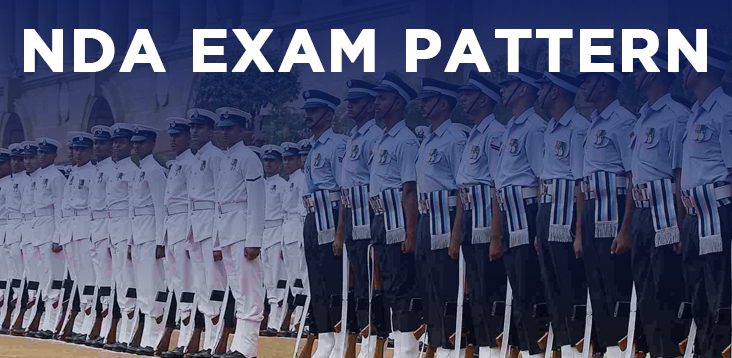NDA EXAM PATTERN

NDA exam pattern
One of the most difficult and prestigious tests in India is paralleled with the National Defence Academy (PATTERN) examination. The National Defence Academy (NDA) exam , which is exceptionally challenging, evaluates applicants who want to join the Indian Armed Forces on both their mental and physical prowess in NDA exam pattern. The purpose of the exam is to evaluate the candidate’s knowledge, analytical and reasoning abilities, and stress tolerance. It is crucial to remember that the NDA exam is only the first step towards a rewarding military career. After selection, the true adventure begins with arduous training and acclimatisation to the rigors of national service.
NDA is conducted by the Union Public Service Commission (UPSC) twice a year. Thousands of candidates nationwide take this NDA exam, to fulfil their desire to join the Indian Armed Forces. For admission to the Indian Army, Navy, and Air Force, the Union Public Service Commission (UPSC) holds the National Defence Academy (NDA) exam pattern is twice a year. Aspiring applicants must be aware of the NDA exam format in or“–der to improve their chances of passing the exam given how competitive it’s pattern. The following article would give a deeper knowledge and a detailed information about the NDA exam pattern, including the format, syllabus, and scoring system.
NDA Exam Structure:
A written exam and an interview with the Service Selection Board (SSB) are both components of the two-stage selection procedure for the NDA exam pattern. The written exam consists of two papers: the General Ability Test and the Mathematics Paper. (GAT). Five hours are allotted in the exam pattern, which consists of two objective multiple-choice examinations. While the GAT exam evaluates the candidate’s English language ability, general knowledge, and logical reasoning skills, the mathematics paper checks the candidate’s understanding of high school mathematics.
The General Ability Test and the Mathematics paper. (GAT). The GAT and Mathematics exams are both given on the same day, with the GAT taking place in the morning. Candidates get 2.5 hours to finish each paper in the pen and paper format of the exam.
The first subject of the NDA exam is the mathematics examination, which comprises of 120 questions for 2.5 marks each. There are two halves to the exam paper: the first section has 50 questions, and the second section has 70 questions. Topics including algebra, trigonometry, geometry, mensuration, statistics, and probability are covered in the mathematics paper’s syllabus. Candidates are expected to have a solid grasp of the principles of mathematics because the questions in the mathematics exam paper are based on the 10+2 level.
The second paper of the NDA exam, the General Ability Test (GAT), has 150 questions with a maximum score of four. The exam is divided into two halves, the first of which is made up of questions on English, and the second of which is made up of questions on general knowledge. Vocabulary, grammar, comprehension, and usage are among the topics covered on the English section’s syllabus. Physics, chemistry, general science, geography, current events, history, the freedom movement, and other subjects are covered in the general knowledge part.
The NDA exam uses a stringent scoring system with deducted points for erroneous responses. While no points are deducted for questions that go unanswered, 0.33 points are subtracted for each erroneous answer. The General Ability Test carries a maximum score of 600, whereas the Mathematics paper carries a maximum score of 300. Performance on both examinations and in the SSB interview will determine which candidates move on to the next round.
Candidates are summoned to the SSB interview, which takes place over five days, after passing the written exam. A candidate’s personality, capacity for leadership, and aptitude for a career in the armed forces are evaluated during the SSB interview. Only those who pass the SSB interview, which is a thorough assessment of a candidate’s mental and physical capabilities, are suggested for admission to the National Defence Academy. A candidate who successfully completes the National Defence Academy’s three-year undergraduate programme in the Science, Arts, or Commerce stream is commissioned as an officer in the Indian Armed Forces. Young aspirants have a fantastic opportunity to serve their country and have a rewarding career in the armed forces thanks to the NDA exam.
The NDA exam pattern is created to evaluate a candidate’s skills and readiness for a position in the Indian Army, Navy, or Air Force. The test consists of two papers: a mathematics paper and a general ability test (GAT) in the NDA exam pattern. Incorrect answers receive a failing grade on both papers. Candidates are anticipated to have a solid grasp of the principles of mathematics and general knowledge. The exam’s syllabus is based on the 10+2 level.To effectively prepare for the exam, prospective applicants must be familiar with the NDA exam format. To increase their efficiency and accuracy, candidates should practice the previous year’s question papers and take mock exams. Aspiring candidates can improve their chances of passing the NDA exam and obtaining a rewarding career in the Indian armed services by practicing properly and comprehending the exam format.


